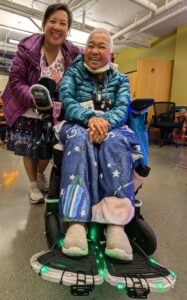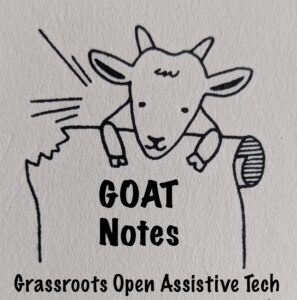In a collaboration between GOAT and San Francisco’s Independent Living Resource Center, we held a pilot workshop in downtown SF last month, where we provided lights, reflectors, reflective tape, and other useful modifications for mobility gear.
This is a photo heavy post! Here’s me smiling to welcome you to this workshop:
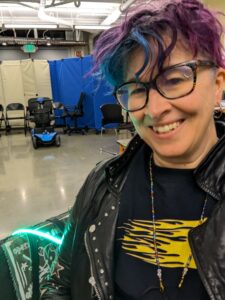
We hosted at ILRCSF, where Vince Lopez runs a free wheelchair repair program. There, SF residents can get maintenance and repair done on their tech – and if you get stuck at home or on the street with a broken chair, Vince will come out, fix the chair or get you to a safe place and take the chair for repairs. You can even borrow a loaner powerchair, scooter, or manual chair. Also from ILRCSF, Marisol Ferrante joined us, to show off the Nick Feldman assistive tech lending library, another great free resource.
Vince displaying a walker with spiral LEDs:
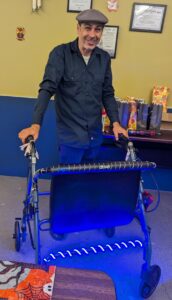
We laid out all the gear that we bought to try out for the event, including reflectors and headlamps made for bicycles, reflective tape, and various kinds of LED strips; mounting clamps, straps, cable ties, gaffer tape, and portable usb battery packs.
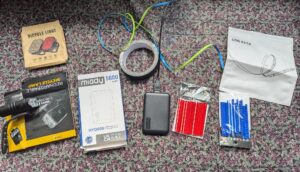
None of this is very “high tech” but having it all there together made a great introduction to thinking about ways to modify mobility gear. When you set out to do this, you have several issues in play:
* DURABILITY: The mods need to be very durable for heavy use, or easily replaceable.
* PINCH POINTS: You need to be aware of how your chair, scooter, walker, etc. fold or are put into storage or, say, a car trunk, so you avoid putting any fragile components onto “pinch points”.
* ATTACHMENT POINTS: You need to consider ways to attach things to your gear. That may mean velcro or cable ties to a metal tube frame, or some other method of attachment. Clamps meant for motorcycles, bikes, or camera tripods often work well, but every wheelchair is different, and people also have different use patterns for them.
* POWER: If you are dealing with electronics, as we were with light strips, you need a power source. I like external battery packs, because they are easy to attach to a frame, or put into a small pouch.
* COST: Often, cheaper is better! It can be a tradeoff between durability and cost, though.
* DIY-ability: You may need easy do-it-yourself solutions. Ideally we would have the resources of an auto body shop, and be able to cut and weld metal, but that isn’t always realistic!
We had a blast setting people up with gear. Everyone had a try at installing their own equipment or working with people who came with them to get lights on their walkers and wheelchairs.
Judy worked with me and her daughter to line the bottoms of her foot rest plates with twinkly christmas-light style LEDs. The LEDs also had a remote control so she could change their color. She also asked for two headlights pointing downwards from the footplate so that it would be easier for her to see curbs or bumps in the sidewalk.
Part of the fun of working with other wheelchair users for me is always seeing how they have come up with their own solutions. Judy’s main hack was that she had dozens of rubber bands of all sizes around her powerchair arm. She used these to keep her phone in place on the wide arm, and then set up the remote control for the lights on the other arm of the chair. I am adding the deceptively simple (and cheap!) “plain old rubber bands” solution to my tool box!
While we installed the lights I also noticed Judy’s foam insulation tape added to the rim of her footplates. If you have been in a powerchair user’s house you may have noticed some dents in the walls! And things like protective strips along corners that stick out, because a powerchair packs a lot of force even at low speeds. The easily replaceable, cheap foam strips are a great idea to save wear and tear on your walls and other people’s shins! But, Judy’s daughter mentioned they peel off and look kind of bad as well. I suggested narrow black gaffer tape wrapped around the foam and foot plates. It isn’t perfect, it won’t last forever, but it will look nicer and will make the foam last for a year or two instead of a month. To refresh it — just add more tape! Gaffer tape is more expensive than duct tape, but is flexible and will last much longer.
Video description: an asian american lady in a powerchair, waving, and her daughter, posing with smiles as the lights under the chair’s footrests blink and glow.
Deniz came with a travelscoot and a walker, and her own pit crew who were very enthusiastic helpers! They went for the lights, and installed COB (chip on board) LED strips along with a cable splitter and a battery pack on each device. The Y splitter means you can symmetrically install two light strips and plug them into one centrally located battery pack. Their install job was flawless!
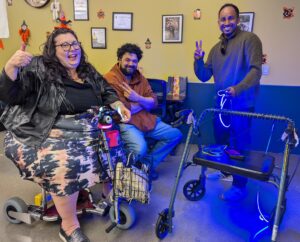
Bill tried out some lights of various kinds, including spoke reflectors for a manual chair. These spoke covers are small and fiddly and annoying to install, but they are also cheap and last a good long time. They also may pop off occasionally and need replacing, but I prefer that to having peeling or scraped up reflector tape making my spokes look all tattered. Bill did a few and got help with more, and then took a pack home to keep working on the project. I would like to find longer covers – they seem to come in this standard size of 3 inches and so you need multiple tubes per spoke. How much easier if they were longer! Let me know if you find a good source for these.
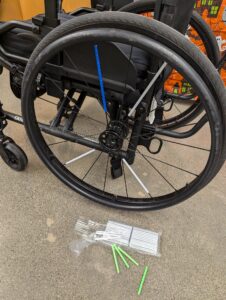
A lady I met at the season opener for Philhamonia Baroque took my flyer and, fabulously, showed up with her husband and her very snazzy European style walker. She did a great job installing an LED strip set, and got a tuneup and some bolts replaced on her walker by Vince. I think that was true for others as well at the workshop.
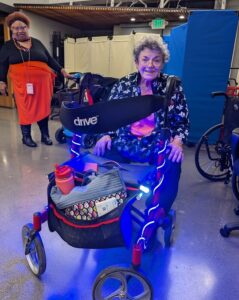
Of course, one of the goals of our workshop was to let people know they can use ILRCSF’s free repair program! Marisol also led several people on tours of the Nick Feldman Lending Library where you can borrow all kinds of useful gear, try it out to see if you like it, or just keep it while you need it and return when your circumstances change. I have used this program in the past and it was incredibly helpful.
We had so much lively discussion during the workshop. Gear reviews, complaints about what doesn’t make sense about either the DME industry, health issues and health care of course, Right to Repair laws now in play in California, and plain old brainstorming about future events. I was so pleased that everyone wanted MORE hands on, DIY events in the future!
The whole event was a lot of fun. We had planned for 2 hours, but ended up staying for over 3 hours. I think next time we will try to get more helpers – because modding any assistive tech is so individual and needs individual attention, brainstorming, experimentation, and so on! And, we could try for an entire afternoon or spanning late afternoon and early evening.
Some participants want to volunteer for our next event! That may be in December or January and will likely add some other category of modification — I’m thinking about pouches and cup holders as our next focus. They are simple, and everyone wants them, but figuring out what exactly will work for a person and their device is a complex process. It may end up being clamps like the motorcyle and bike ones we had for our Halloween workshop, or it can be something like fabric, leather, canvas, or even duct and gaffer tape along with velcro. Leather working tools can also be super useful in creating custom pouches and bags to attach to a chair!
We will also be looking in future to host similar workshops in the East Bay jointly with the CIL and other organizations! Stay tuned!
Here’s a few more photos:
Me and Deniz in conversation,
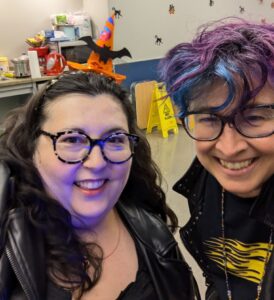
Walker DIY in progress,
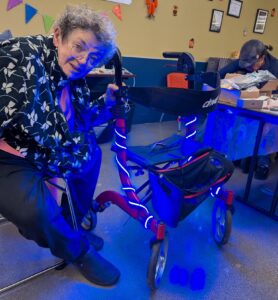
Judy and daughter,
